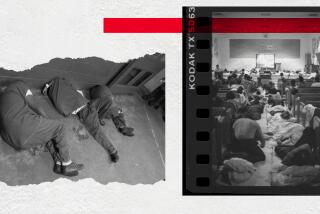A Visit to the World of a Schizophrenic
- Share via
Neither of us had ever been to a jail before. We were extremely apprehensive. After fighting traffic and taking wrong turns and finding our way through an increasingly seedy side of town--abandoned buildings and not-so-abandoned buildings, graffiti, potholes, trash, bag ladies and bums, addicts and alcoholics, people who have given up and people who are mentally ill--after the trauma of driving through Skid Row, we finally arrived at the Los Angeles County Jail.
My friend Susie and I were visiting her 23-year-old son Joe (I have changed both their names). Joe is afflicted with schizophrenia. One percent of the world’s population has schizophrenia. Its onset is in young adulthood--most often between the ages of 18 and 25. It strikes the bright and the talented, often with little warning, and it shows no racial discrimination. Last month, Susie visited Joe at Augustus Hawkins psychiatric hospital. Now it’s the forensic unit at County Jail.
A former homeless mental patient, speaking at a conference recently, said that being in jail had advantages over living on the streets--such as three meals a day, a place to sleep, and a chance to shower once in a while. But to visit someone there is a sobering experience. My heart was pounding.
We left our driver licenses with the guard at the barred window, opened the heavy steel door and entered a room with a scuffed floor and gray concrete walls. In the wall facing the entry door are the visiting windows--immovable bulletproof windows with a small metal stool attached to the wall under each one. Visitors communicate by phone.
Susie sat on one of the stools and waited and waited . . . and waited for 45 minutes. I went outside and asked the guard at the window why Joe wasn’t down to see his mother. The guard said that Joe had been told twice that his mother was there. Someone would escort him to the window since he wasn’t coming on his own. Another 20 minutes, then Joe appeared, looking thin in his baggy hospital section garb. No smile.
He wanted to be released and he wanted to come home. Nothing was the matter with him--he denied being mentally ill. He refused to take any medication or talk about it. He said that if his mother didn’t get him out of there he would go to New York upon release and she would never hear from him again.
Susie didn’t dare try to get him out. She knew from experience that she couldn’t handle him. What she wanted, and had wanted in the past, was to get him into a hospital--to get medication and help for him. But there is a severe shortage of beds in county and state hospitals, and Joe has no insurance for private hospitalization. It seemed as if he always became acute at the wrong time--when no beds were available.
Joe didn’t belong in jail. He was picked up by the police because he was blowing kisses to imaginary ladies, being bothersome to the proprietor of a liquor store near the board-and-care home where he had been staying, and interfering with traffic.
Trial-and-Error Process
His mother wished he had been hospitalized instead of jailed. She wished he had been placed in a state hospital where he could have been held for more than 14 days, so that maybe the right medication could have been found for him. Finding the right medication for someone with schizophrenia is a trial-and-error process. Each person’s system responds to medications differently, and so little is known about the disease that no test is available to determine what medicine will control the symptoms. Research is what is needed, but funding for research for mental illness is infinitesimal.
The majority of patients afflicted with schizophrenia accept their illness to the extent that they accept medical care to help them cope with their disability. But then there are a small number like Joe, who deny their illness, and our laws and our society give them no protection. We used to put them in hospitals. Now we put them in jail or leave them to wander homeless on the streets, likely victims of aggression or disease.
More to Read
Sign up for Essential California
The most important California stories and recommendations in your inbox every morning.
You may occasionally receive promotional content from the Los Angeles Times.













